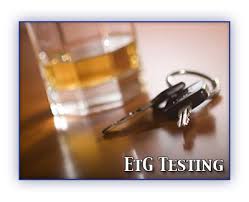… EtG and EtS are direct metabolites of alcohol (ethanol). Their presence in urine is used to detect recent ethanol ingestion—even after ethanol is no longer measurable. Detectable up to 80 hours after ingestion, the presence of both EtG and EtS in urine is a reliable confirmation method and indicator of ethanol ingestion. EtG detects recent ingestion more accurately and for a longer period of time than standard alcohol tests.
National Drug Screening offers state-of-the-art technology and skilled laboratory staffing to ensure accurate EtG/EtS analysis. EtG alcohol testing is offered in all areas of the United States at our drug testing centers. Immediate service for EtG alcohol testing is available from National Drug Screening centers in every city. If you need an EtG alcohol test today, call our toll free number for immediate service.
EtG is only detected in urine when alcohol is consumed. This is important since it is possible to have alcohol in urine without drinking. Alcohol in urine without drinking is due to the production of ethanol in vitro. Ethanol in vitro is spontaneously produced in the bladder or the specimen container itself, due to fermentation of urine samples containing sugars (diabetes) and yeast or bacteria. Since the ethanol produced is not metabolized by the liver, EtG will not be produced and will therefore not be detected in a urine containing alcohol as a result of fermentation.
Ethyl glucuronide (EtG) is a direct metabolite of alcohol (ethanol). Its presence in urine may be used to detect recent ethanol ingestion, even after ethanol is no longer measurable. In addition to EtG, scientific studies have identified ethyl sulfate (EtS) as a second specific metabolite or biomarker of ethanol. For this reason, we test and report EtS, in conjunction with EtG, to confirm recent ethanol ingestion or exposure. The presence of EtG and EtS in urine indicates that ethanol was ingested within the previous 3 to 4 days, or approximately 80 hours after ethanol has been ingested.
EtG alcohol testing is an essential tool for zero tolerance alcohol treatment programs and court ordered testing for alcohol.
Key Benefits of Using EtG test Include:
- Ideal for zero tolerance and abstinence situations
- Strong indicator of alcohol ingestion within the previous 3 to 4 days
- Acts as an early warning system to detect t rends towards relapse
- Tests are performed by LC/MS/MS on state of the art equipment for accuracy and reliability
- Thirty-six hour turnaround time from receipt of specimen
- EtG may be run on urine specimens in conjunction with other drug testing panels
- Detects recent usage more accurately and for a longer period of time than standard testing
- EtG is only evident when alcohol is consumed and is not produced as a result of fermentation
- Allows monitoring in alcohol treatment programs
Why do you report EtG levels at two different cut-offs 100 ng/ml, 250mg/ml and 500 ng/ml?
We do this to provide complete information on which to base a sound clinical decision. EtG can be detected by our assay system at levels even below 100 ng/ml, but we build in a “margin of safety” so that at 100 ng/ml we are very certain that EtG is present, indicating even small amounts of drinking. However, there have been some reports in the literature, as well as concern raised in legal cases, that other sources of alcohol (e.g. mouthwash, hand sanitizer) might cause levels of EtG above 100 ng/ml to be detected in the urine. Although these situations are rare, and hard to replicate under controlled conditions, in those instances where a higher level of certainty is needed (forensic cases etc.) the clinician might want to use the 250 or 500 ng/ml cut-off.
EtG alcohol testing should not be used for standard workplace alcohol testing. The Substance Abuse and Mental Health Services Administration (SAMHSA) has issued an advisor warning: The EtG (ethyl glucuronide) urine test, often used to detect alcohol use among individuals legally prohibited from drinking because of their job or parole status, is “inappropriate” as the sole basis for a definitive, life-altering decision. SAMHSA issued the warning after investigating claims of false-positive test results.
The EtG test and other similar highly sensitive tests are not able to distinguish between alcohol absorbed into the body from exposure to many common commercial and household products containing alcohol or from the actual consumption of alcohol. Calling such a test “positive” for consumption or relapse, especially at low concentrations, could have devastating consequences for someone who signs an alcohol abstinence contract or is required to be abstinent by law.
“This Advisory is a clarification,” said addiction psychiatrist Kenneth Hoffman, M.D., M.P.H., of SAMHSA’s Center for Substance Abuse Treatment Division of Pharmacologic Therapies. “The Agency wants officials to know that the EtG test, for example, is fine for use in clinical settings. But it should not be used as a stand-alone test in a forensic situation where someone’s job is at stake.”
National Drug Screening agrees with SAMHSA and does not provide EtG testing for employer based drug testing programs and drug free workplace problems. For workplace alcohol testing should be done with breath alcohol testing or with blood alcohol testing.







